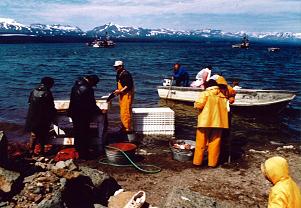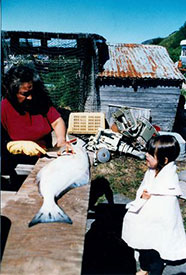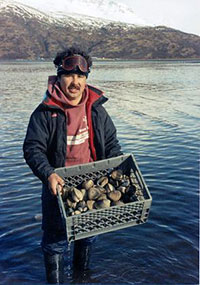Chignik Area
Subsistence Fishing
Fishing Information
Salmon
 All five species of Pacific salmon have historically and continued to be a major subsistence food source for people living in the communities of the Chignik Management Area (CMA). These species include: Chinook (Oncorhynchus tschawytscha), sockeye (O. nerka), coho (O. kisutch), pink (O. gorbuscha), and chum (O. keta) salmon.
All five species of Pacific salmon have historically and continued to be a major subsistence food source for people living in the communities of the Chignik Management Area (CMA). These species include: Chinook (Oncorhynchus tschawytscha), sockeye (O. nerka), coho (O. kisutch), pink (O. gorbuscha), and chum (O. keta) salmon.
The role of salmon in the wild food diet varies from community to community, and is affected primarily by salmon abundance located within the community's local fishing waters. For example, sockeye salmon is the most commonly harvested species of salmon in the three Chignik communities as well as by other subsistence fisherman that do not reside year around in these communities. Perryville residents generally harvest more coho salmon because these fish are more abundant in their area.
Subsistence harvests of salmon fish are regulated by a permit issued by the ADF&G area biologist at the Chignik River Weir in the summer months as well as with local vendors in each of the four communities. The permit is free but only legal for Alaska residents. Bag limits, gear type, and length of fishing period, and restrictions to commercial fisherman are stipulated on the permit or can be viewed in the annual Subsistence and Personal Use Statewide Fisheries Regulation Booklet. See also online subsistence finfish fishery regulations and personal use fishery regulations.
Subsistence salmon or "home pack" may also be removed from a Chignik commercial catch, but must be recorded on their commercial fish tickets. Home pack amounts are not included in the subsistence salmon harvest permit record. Rod and reel fishing is legal in this area under sport fishing regulations, however this gear type cannot be used for subsistence fishing under state regulations.
State regulations apply on all state, private and federal lands where authorized. Private landowners may restrict entry on their land. Much of the Chignik Management Area lies within The Alaska Peninsula National Wildlife Refuge. Local residents in all the Chignik area communities are allowed to subsistence fish under federal regulations on federal lands and waters within the CMA, due to positive customary and traditional use findings by State Board of Fisheries. Chignik area federal subsistence regulations differ some from the state regulations. Contact the Federal Office of Subsistence Management for more information on the federal subsistence fisheries at: phone: (800) 478-1456; website: http://www.doi.gov/subsistence/index.cfm; email: Subsistence@fws.gov .
Halibut
 Under state regulations, subsistence halibut may be taken only by a single-hand held line with not more than two hooks attached with two daily bag limits in possession. Bag limits, gear type, and length of fishing periods for non-salmon finfish are stipulated in the "Annual Subsistence and Personal Use Statewide Fisheries Regulations" booklet
(see subsistence finfish fishery regulations). Halibut is the only species that has an annual harvest assessment for non-salmon fisheries in the Chignik area.
Under state regulations, subsistence halibut may be taken only by a single-hand held line with not more than two hooks attached with two daily bag limits in possession. Bag limits, gear type, and length of fishing periods for non-salmon finfish are stipulated in the "Annual Subsistence and Personal Use Statewide Fisheries Regulations" booklet
(see subsistence finfish fishery regulations). Halibut is the only species that has an annual harvest assessment for non-salmon fisheries in the Chignik area.
Under federal regulations, residents and tribal members of the four Chignik communities qualify to participate in a federal subsistence halibut program, but need to register to participate. Contact National Marine Fisheries Service for more information: http://www.fakr.noaa.gov/ram/subsistence/faq.htm. (Or) phone: (800) 304-4846.
Other Finfish
 All non-salmon fish other than steelhead or rainbow trout may be taken for subsistence at any time by Alaska residents without a permit. Steelhead and rainbow trout may be caught legally and retained for subsistence purposes if caught incidentally in other state subsistence finfish net fisheries, and they must be recorded on the state subsistence salmon permit. Bag limits, gear type, and length of fishing periods for non-salmon finfish are stipulated in the "Annual Subsistence and Personal Use Statewide Fisheries Regulations" booklet (see subsistence finfish fishery regulations). Other than halibut, there is no annual harvest assessment for non-salmon fisheries in the Chignik area. However, The Subsistence Section has documented through systematic household interviews non-salmon fish species for which subsistence uses in the Chignik management area. Some non-salmon fish species available for harvest in the Chignik Management Area include:
All non-salmon fish other than steelhead or rainbow trout may be taken for subsistence at any time by Alaska residents without a permit. Steelhead and rainbow trout may be caught legally and retained for subsistence purposes if caught incidentally in other state subsistence finfish net fisheries, and they must be recorded on the state subsistence salmon permit. Bag limits, gear type, and length of fishing periods for non-salmon finfish are stipulated in the "Annual Subsistence and Personal Use Statewide Fisheries Regulations" booklet (see subsistence finfish fishery regulations). Other than halibut, there is no annual harvest assessment for non-salmon fisheries in the Chignik area. However, The Subsistence Section has documented through systematic household interviews non-salmon fish species for which subsistence uses in the Chignik management area. Some non-salmon fish species available for harvest in the Chignik Management Area include:
- Halibut (Hippoglossus stenolepis)
- Pacific Gray Cod (Gadus macrocephalus)
- Black Cod/ Sablefish (Anoplopoma fimbria)
- Eulachon ("candlefish") (Thaleichthys pacificus)
- Herring (Clupea harengus pallasii)
- Starry flounder (Platichthys stellatus)
- Black Rockfish (Sebastesmelanops)
- Greenling (Hexagrammos decagrammus)
- Rainbow trout (Oncorhychus)
- Dolly Varden (Salvelinus malma)
- Grayling (Thymallus arcticus)
- Herring and Herring spawn on kelp (Clupea harengus)
Shellfish
 A study to observe and document the harvest, processing, preservation and use of subsistence salmon by residents of Chignik Bay, Chignik Lagoon, Chignik Lake and Perryville, is being conducted in the Chignik Management area. This study will also 1) evaluate the contemporary and historical importance of salmon to the economy and culture of the communities in this region and 2) document local Chignik traditional knowledge of salmon and local environment, climate change and effects on local resources and the ocean. This project is funded by the Alaska Sustainable Salmon Fisheries Fund and will be conducted from 2010-2013. It is intended to update prior research done in 1990 in these communities by the Division of Subsistence. Improved documentation of subsistence harvests supports effective salmon management and is essential for the Alaska Board of Fisheries to meet its statutory mandate to provide reasonable opportunities for subsistence uses. Understanding trends in the Chignik Management Area subsistence salmon fishery, including factors influencing participation in the fishery and harvest levels, will be critical toward management of adequate salmon populations and habitat issues in the Chignik and Western Perryville salmon districts. For more information about the Alaska Sustainable Salmon Fund and other projects
see: http://www.akssf.org.
A study to observe and document the harvest, processing, preservation and use of subsistence salmon by residents of Chignik Bay, Chignik Lagoon, Chignik Lake and Perryville, is being conducted in the Chignik Management area. This study will also 1) evaluate the contemporary and historical importance of salmon to the economy and culture of the communities in this region and 2) document local Chignik traditional knowledge of salmon and local environment, climate change and effects on local resources and the ocean. This project is funded by the Alaska Sustainable Salmon Fisheries Fund and will be conducted from 2010-2013. It is intended to update prior research done in 1990 in these communities by the Division of Subsistence. Improved documentation of subsistence harvests supports effective salmon management and is essential for the Alaska Board of Fisheries to meet its statutory mandate to provide reasonable opportunities for subsistence uses. Understanding trends in the Chignik Management Area subsistence salmon fishery, including factors influencing participation in the fishery and harvest levels, will be critical toward management of adequate salmon populations and habitat issues in the Chignik and Western Perryville salmon districts. For more information about the Alaska Sustainable Salmon Fund and other projects
see: http://www.akssf.org.
